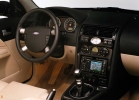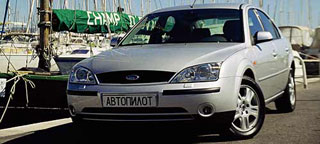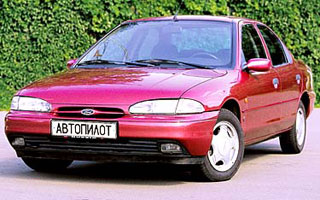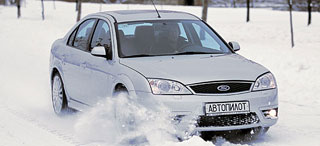Test drive Ford mondeo sedan 2000 - 2003 sedan
Creation Mondeo. How it was
 Today it is difficult to call the exact date of birth of the CDW27 project; Perhaps the first date in his history was the November morning of 1985, when Ford Motor Co. Fila Benton was visited by John Ouldfield, the executive director of the corporation, responsible for the engineering and design direction. They talked about what benefits a program can bring to develop a model that can fit into the requirements of several key markets at once. I must say that Ford Motor has some experience in this area has already sophisticated. The first so -called world car was the 1980 Ford Escort, which went on sale both in Europe and the USA. Alas, the brilliant idea turned out to be hopelessly spoiled at the stage of implementation - by the time the European Escort and American Ford Escort/Mercury Lynx series had only two common details: a water pump and a proprietary emblem. As analytical studies have shown, the fundamental mistake was that the model was designed by different teams on both sides of the Atlantic.
Today it is difficult to call the exact date of birth of the CDW27 project; Perhaps the first date in his history was the November morning of 1985, when Ford Motor Co. Fila Benton was visited by John Ouldfield, the executive director of the corporation, responsible for the engineering and design direction. They talked about what benefits a program can bring to develop a model that can fit into the requirements of several key markets at once. I must say that Ford Motor has some experience in this area has already sophisticated. The first so -called world car was the 1980 Ford Escort, which went on sale both in Europe and the USA. Alas, the brilliant idea turned out to be hopelessly spoiled at the stage of implementation - by the time the European Escort and American Ford Escort/Mercury Lynx series had only two common details: a water pump and a proprietary emblem. As analytical studies have shown, the fundamental mistake was that the model was designed by different teams on both sides of the Atlantic. The Ouldfield team studied in detail the features of requests from customers of CD classes (according to the Ford Specifications) in Europe and the USA and found that they are not just similar, but almost identical, distinguished only by nuances. The second important conclusion was a statement of the impossibility of connecting to the work of all three corporation units - Ford of America, Ford of Europe and Mazda Motor, primarily due to the complexity of the coordination of their actions. Therefore, we decided to stay on the North American and European branches, between which there was an established information exchange on computer networks.
 In June 1986, at the headquarters of Ford Motor Co. The Holy Trinity gathered in Dirborn - the chairman of the board, the president and head of the financial department. The large bosses once again listened to Ouldfield's arguments and gave the go -ahead to implement the global project under the coded designation CDW27 (the CDW abbreviation was deciphered as the CD Car for the World - the World CD -class car, and the number 27 was used just so that no one would have guessed). After long thoughts, the bulk of the design work was entrusted with Ford of Europe; Benton's words were a decisive argument: Europeans are accustomed to cars of this class. They know, perhaps, even better than us, how great their role is in society.
In June 1986, at the headquarters of Ford Motor Co. The Holy Trinity gathered in Dirborn - the chairman of the board, the president and head of the financial department. The large bosses once again listened to Ouldfield's arguments and gave the go -ahead to implement the global project under the coded designation CDW27 (the CDW abbreviation was deciphered as the CD Car for the World - the World CD -class car, and the number 27 was used just so that no one would have guessed). After long thoughts, the bulk of the design work was entrusted with Ford of Europe; Benton's words were a decisive argument: Europeans are accustomed to cars of this class. They know, perhaps, even better than us, how great their role is in society. In the Old World, the car should replace the Sierra model and will be produced in the Belgian gent, and in the USA it will replace the Ford Tempo/Mercury Topaz twins, and the plant in Kansas City will be rewritten under its production. European and North American options will have common platform, body (with small differences in the design), suspension (but differently configured), engines and transmission. The four -cylinder motors of the promising Zeta family and a mechanical gearbox will be designed in Europe and launched a series in the UK and Mexico, and a 2.5 -liter V6 and the machine will become purely American - both in the geography of development and the place of release. European buyers will be offered a sedan, a hatchback, and a station wagon; The Americans will have to be content with only a four -door version. Then the leadership was determined with the terms of the premiere of the car - it will be held in March 1993 at a car dealership in Geneva. Thus, the action plan for the next seven years was painted. All subsequent issues were resolved mainly on video conferences that have finished the practice of mass migration of employees of all levels through the ocean. Well, the head of the project was appointed John Ouldfield who had already managed to work well.
 The first step was to choose a reference point. During 1987, the European and American groups of engineers received competing manufacturers by a copy of models-classmates. Based on the results of the tests, a car that was successfully sold in both markets was chosen as a starting point, and in the United States replaced Ford Escort from the leading positions. It was a third -generation Honda Accord. Accordingly, each of the selected parameters of the chord - accelerated dynamics, brake dynamics, smoothness, controllability, vibration insulation, gear clarity, etc. - 100%were conditionally assigned. At the same time, other cars exceeded the Japanese in separate parameters, and then the estimate increased to 105%, 110%, 115%and so on from a particular chord quality.
The first step was to choose a reference point. During 1987, the European and American groups of engineers received competing manufacturers by a copy of models-classmates. Based on the results of the tests, a car that was successfully sold in both markets was chosen as a starting point, and in the United States replaced Ford Escort from the leading positions. It was a third -generation Honda Accord. Accordingly, each of the selected parameters of the chord - accelerated dynamics, brake dynamics, smoothness, controllability, vibration insulation, gear clarity, etc. - 100%were conditionally assigned. At the same time, other cars exceeded the Japanese in separate parameters, and then the estimate increased to 105%, 110%, 115%and so on from a particular chord quality. 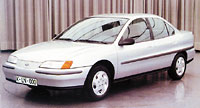 So the standard image of the perfect car was created. But what should you strive for? Surpass accord? Materialize the same standard? Or do it even better? Then how much - by 15%, one and a half times, in two? It is clear that the CDW27 is obliged to leave behind all the parameters not only modern models, not only those cars that will appear in the near future, in particular, Opel Vectra and Volkswagen Passat B3, but be the most competitive and competitive through twelve. First of all, it was necessary to determine the concept that has to dominate in the mid -nineties, or rather, to predict what kind of concept it would be. And then the Fordovites came across the latest Peugeot 405, built in the Cab Forward style, that is, with a salon shifted to the front axis. (A few months later, a French car with a convincing advantage over rivals will win a 1988 car in the competition.) So, the starting point number two became the 405th. However, making a bet on Cab Forward, it was great to take risks, since human consciousness has a fair conservatism. This concerned not only consumers, but also the leadership of the Ford Motor, which at first skeptically reacted to the idea of \u200b\u200bcrossing uncomplicated chopped forms of chord with unusual pro-contractions of swift Peugeot. The final task of the designers sounded something like this: to predict the trends in the coming years and find the form and style of the near future. The basis for the CAB Forward layout is the basis. The task, as you understand, is archglable. The development of the appearance of the machine was entrusted to four designer centers - three Ford, in Dirborne, San Jose and Cologne, as well as the Italian company Carrozzeria Ghia. Manfred lamp was responsible for the coordination of their activities. In the spring of 1987, all four groups brought their sketches to Cologne, where they were discussed and adjusted. There were no victorious and losers - for the CDW27 it was supposed to borrow the best of all projects. Then the time has come for the manufacture of fiberglass layouts in full size. They were reduced in a full-time rate, as a result of which the basic project was chosen by Kelnsky, which was distinguished by a sports style and large arches of the wheels. From that moment, the German center was appointed head; In parallel, the Ford Studio in the English city of Datton began to develop the interior.
So the standard image of the perfect car was created. But what should you strive for? Surpass accord? Materialize the same standard? Or do it even better? Then how much - by 15%, one and a half times, in two? It is clear that the CDW27 is obliged to leave behind all the parameters not only modern models, not only those cars that will appear in the near future, in particular, Opel Vectra and Volkswagen Passat B3, but be the most competitive and competitive through twelve. First of all, it was necessary to determine the concept that has to dominate in the mid -nineties, or rather, to predict what kind of concept it would be. And then the Fordovites came across the latest Peugeot 405, built in the Cab Forward style, that is, with a salon shifted to the front axis. (A few months later, a French car with a convincing advantage over rivals will win a 1988 car in the competition.) So, the starting point number two became the 405th. However, making a bet on Cab Forward, it was great to take risks, since human consciousness has a fair conservatism. This concerned not only consumers, but also the leadership of the Ford Motor, which at first skeptically reacted to the idea of \u200b\u200bcrossing uncomplicated chopped forms of chord with unusual pro-contractions of swift Peugeot. The final task of the designers sounded something like this: to predict the trends in the coming years and find the form and style of the near future. The basis for the CAB Forward layout is the basis. The task, as you understand, is archglable. The development of the appearance of the machine was entrusted to four designer centers - three Ford, in Dirborne, San Jose and Cologne, as well as the Italian company Carrozzeria Ghia. Manfred lamp was responsible for the coordination of their activities. In the spring of 1987, all four groups brought their sketches to Cologne, where they were discussed and adjusted. There were no victorious and losers - for the CDW27 it was supposed to borrow the best of all projects. Then the time has come for the manufacture of fiberglass layouts in full size. They were reduced in a full-time rate, as a result of which the basic project was chosen by Kelnsky, which was distinguished by a sports style and large arches of the wheels. From that moment, the German center was appointed head; In parallel, the Ford Studio in the English city of Datton began to develop the interior.  At the next stage, from the summer of 1987 to the summer of 1988, the form was filled with content: the formation of the proportions of the car took place taking into account the features of mechanical filling. Then eleven Sierr, equipped with engines, transmission and suspension intended for the CDW27, left for the testing ground. The short motor compartment, inevitable for the Cab Forward, was redrawn many times in order to fit all the units in it - of course, this also affected the design of the whole car. Prototypes of the first generation were born, receiving designations 4A, 4V, 4C and 4D. They were also subjected to thorough analysis, according to the results of which four more prototypes were laid: 4E, 4F, 4G and 4N, assigned to the second generation. 4G turned out to be absolutely hopeless, and the California 4F was rather an experiment: the car had an overly large wheelbase and small overhangs. The searches of the form ended with a prototype of 4n, grown from the 4th and represented by the Cologne Center in March 1989. It is curious that 4n was made two -faced for blessing: on the right side of the car there were three side glasses (one, smaller, behind the back door), and two from the left. Choose a two -footed one.
At the next stage, from the summer of 1987 to the summer of 1988, the form was filled with content: the formation of the proportions of the car took place taking into account the features of mechanical filling. Then eleven Sierr, equipped with engines, transmission and suspension intended for the CDW27, left for the testing ground. The short motor compartment, inevitable for the Cab Forward, was redrawn many times in order to fit all the units in it - of course, this also affected the design of the whole car. Prototypes of the first generation were born, receiving designations 4A, 4V, 4C and 4D. They were also subjected to thorough analysis, according to the results of which four more prototypes were laid: 4E, 4F, 4G and 4N, assigned to the second generation. 4G turned out to be absolutely hopeless, and the California 4F was rather an experiment: the car had an overly large wheelbase and small overhangs. The searches of the form ended with a prototype of 4n, grown from the 4th and represented by the Cologne Center in March 1989. It is curious that 4n was made two -faced for blessing: on the right side of the car there were three side glasses (one, smaller, behind the back door), and two from the left. Choose a two -footed one.  Now the CDW27 project has switched to a qualitatively different level. In September 1989, the running and aerodynamic tests of several working prototypes started. Looking ahead, let's say that they were built by four hundred: 240 in Europe and 160 in the USA. The power structure of the body, energy -absorbing zones, as well as the design of all units, were calculated on the latest CRAY computers. Finally, in March 1990, a key event took place in the biography of the machine: at a historical meeting in Dirborne, sixteen leading managers of the corporation finally approved the CDW27 program, where the requirements for dynamics and ergonomics, quality and resistance to aging, the level of passive and active safety and environmentalities were strictly stipulated. Easy to maintenance and probable tax rates from owners, organization of production and expenses on it and, of course, designed net profit from each car. By 1991, the main nodes were also ready. In the UK, the development of a new Zeta family (later named Zetec) ended, the first of which, 1.6-liter, debuted on models on Escort/Orion and Fiesta in the spring of 1992. Later, 1.8- and 2-liter versions of this four-cylinder engine with two camshafts and four valves on the cylinder, so attractive with its efficiency and a low level of toxicity of the exhaust.
Now the CDW27 project has switched to a qualitatively different level. In September 1989, the running and aerodynamic tests of several working prototypes started. Looking ahead, let's say that they were built by four hundred: 240 in Europe and 160 in the USA. The power structure of the body, energy -absorbing zones, as well as the design of all units, were calculated on the latest CRAY computers. Finally, in March 1990, a key event took place in the biography of the machine: at a historical meeting in Dirborne, sixteen leading managers of the corporation finally approved the CDW27 program, where the requirements for dynamics and ergonomics, quality and resistance to aging, the level of passive and active safety and environmentalities were strictly stipulated. Easy to maintenance and probable tax rates from owners, organization of production and expenses on it and, of course, designed net profit from each car. By 1991, the main nodes were also ready. In the UK, the development of a new Zeta family (later named Zetec) ended, the first of which, 1.6-liter, debuted on models on Escort/Orion and Fiesta in the spring of 1992. Later, 1.8- and 2-liter versions of this four-cylinder engine with two camshafts and four valves on the cylinder, so attractive with its efficiency and a low level of toxicity of the exhaust. The only unpleasant moment occurred in 1990, when a very successful Nissan Primera model entered the market, which forced Fords to reconsider the standards for vibration isolation of the power unit. The engineers laid the engineers on a 16-bit electronic EES-IV electronic control function with a 56KB with a capacity of 56KB and a microprocessor operating at a clock frequency of 18 MHz, capable of performing 1.25 million operations per second. American colleagues also withstood all the deadlines, preparing a completely new V6 V6 alloy engine with a capacity of 170 liters. With. It was built on the so-called modular principle, that is, if desired, it can be turned into eight, ten or even 12-cylinder. The same power unit in the V8 (5.4 liter) is installed on Lincoln Town Car and Ford Crown Victoria. A little later, a 1.8-liter turbodiesel from Sierra TD arrived, which received an intermediate cooling system of the injected air (Intercooler). To work with the engines, two gearboxes were prepared: the modernized five-speed MTX-75 mechanics from Escort/Orion 1.8i and the automatic transmission CD4E designed by the Americans from scratch.
 In the spring of 1991, the car acquired a complete look, and the purpose of the final stage of argument was a gloss. Incidentally, in the hidden of the running qualities of the machine, Jackie Stuart, two-time formula-1 champion, took an active part. By February 1992, the car was completely ready, and soon the world recognized his name. Posters with the Mondeo logo (comes from the French Le Monde - Peace) decorated the whole of Europe, although no one knew anything specific about the car, and many had no idea that there was a mysterious Mondeo behind this mysterious. For the first time in world practice, a massive and insanely expensive advertising company began six months before the presentation of the goods. No less money went to modernize the plant in the Belgian city of Gent, where Mondeo will be produced. To evaluate the size of investments, it is enough to bring this fact: on the assembly conveyor of the plant (by the way, with an infrastructure that occupies an area of \u200b\u200b310 hectares), 95% of welding robots had to be replaced. Yes, what to trifle, because the Ford Motor Corporation set a kind of record, spending an astronomical amount of six billion dollars on the embodiment of the CDW27 project! On November 23, 1992, the first commodity Mondeo left the assembly workshop. The clock, for several years, fed -counted, stopped at 00:00:00.
In the spring of 1991, the car acquired a complete look, and the purpose of the final stage of argument was a gloss. Incidentally, in the hidden of the running qualities of the machine, Jackie Stuart, two-time formula-1 champion, took an active part. By February 1992, the car was completely ready, and soon the world recognized his name. Posters with the Mondeo logo (comes from the French Le Monde - Peace) decorated the whole of Europe, although no one knew anything specific about the car, and many had no idea that there was a mysterious Mondeo behind this mysterious. For the first time in world practice, a massive and insanely expensive advertising company began six months before the presentation of the goods. No less money went to modernize the plant in the Belgian city of Gent, where Mondeo will be produced. To evaluate the size of investments, it is enough to bring this fact: on the assembly conveyor of the plant (by the way, with an infrastructure that occupies an area of \u200b\u200b310 hectares), 95% of welding robots had to be replaced. Yes, what to trifle, because the Ford Motor Corporation set a kind of record, spending an astronomical amount of six billion dollars on the embodiment of the CDW27 project! On November 23, 1992, the first commodity Mondeo left the assembly workshop. The clock, for several years, fed -counted, stopped at 00:00:00. 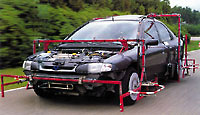


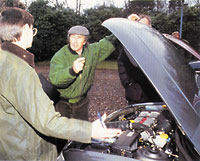

Source: Wheel magazine [No. 37/2000]
Video crash tests Ford mondeo sedan 2000 - 2003
Test drives Ford Mondeo Sedan 2000 - 2003
Crash Test Ford Mondeo Sedan 2000 - 2003
Krassh Test: Detailed Information28%
Driver and passengers
13%
Pedestrians
Ford mondeo sedan 2000 - 2003
Ford mondeo sedan malfunctions: Detailed information| Mondeo sedan 2000 - 2003 | |
|---|---|
| Engine |  |
| Transmission |  |
| Control system and suspension |  |
| Brake system |  |
| Air heating and air conditioning |  |
| Launch and charging system |  |
| Electric components and so on |  |
| Corrosion body stability |





